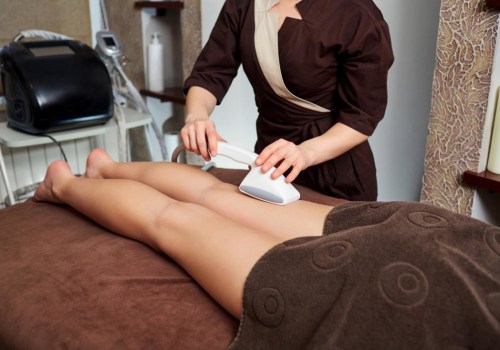In Stamford, CT, the options for nonsurgical fat reduction and cold laser therapy have gained popularity as effective methods for body contouring. Understanding how cold laser therapy works and the nuances between nonsurgical fat reduction techniques is essential for making informed decisions about your wellness journey.
Factors such as safety, the expertise of the provider, and long-term benefits play a crucial role in determining the most suitable approach for achieving your desired results. Stay tuned to unravel the intricacies of these innovative procedures and discover how they can potentially transform your aesthetic goals.
Understanding How Cold Laser Therapy Works
Cold laser therapy, also known as low-level laser therapy (LLLT), harnesses the power of concentrated light to stimulate cellular function and promote tissue healing. The effectiveness of cold laser therapy lies in the specific laser wavelength used, typically in the range of 600 to 1000 nanometers. This wavelength is crucial, as it determines the depth of penetration into the tissues and the extent of energy absorption.
When the cold laser is applied to the skin, tissues absorb the light energy. This energy absorption triggers a series of cellular processes within the body. One key process is photobiomodulation, where the light energy is converted into biochemical signals that help regulate cellular function. This, in turn, enhances the production of adenosine triphosphate (ATP), the energy currency of cells, leading to increased cellular metabolism and tissue repair.
Furthermore, the laser's energy absorption at a cellular level stimulates the production of reactive oxygen species (ROS) and nitric oxide, which play essential roles in reducing inflammation and promoting vasodilation. These mechanisms collectively contribute to tissue healing, pain reduction, and overall therapeutic effects. Understanding the intricate interplay between laser wavelength, energy absorption, and cellular processes is fundamental to comprehending how cold laser therapy works to promote healing and alleviate symptoms. So, if you want to know more about "How Does Cold Laser Therapy Work?" contact Safe Laser Therapy LLC. Their services include laser treatments to assist consumers in giving up smoking, controlling their weight, finding pain relief, reducing stress, detoxifying, skin rejuvenation, and hair regrowth.
Distinctions Between Nonsurgical Fat Reduction And Cold Laser Therapy Work
Here are some distinctions between nonsurgical fat reduction methods and cold laser therapy:
Mechanism of Action:
- Nonsurgical Fat Reduction: Methods like cryolipolysis (CoolSculpting), radiofrequency (RF) therapy and ultrasound use different technologies to target and destroy fat cells non-invasively. Cryolipolysis freezes fat cells, causing them to crystallize and eventually die, while RF therapy and ultrasound use heat or mechanical energy to disrupt fat cells.
- Cold Laser Therapy: Cold Laser Therapy, also known as Low-Level Laser Therapy (LLLT), stimulates cellular activity and promotes the release of stored fat from fat cells without causing cell damage. It does not directly destroy fat cells but rather encourages the body to metabolize and eliminate fat through natural processes.
Primary Purpose:
Nonsurgical Fat Reduction: The primary purpose of nonsurgical fat reduction methods is to reduce localized fat deposits and improve body contours without surgery. These treatments target stubborn areas of fat that are resistant to diet and exercise.
Cold Laser Therapy: Cold Laser Therapy primarily aims to promote tissue healing, reduce inflammation, and alleviate pain. While it may have some effects on fat metabolism, its primary focus is not on fat reduction for cosmetic purposes.
Targeted Areas:
- Nonsurgical Fat Reduction: Nonsurgical fat reduction methods can target specific areas of the body where excess fat accumulates, such as the abdomen, thighs, hips, buttocks, arms, and chin.
- Cold Laser Therapy: Cold Laser Therapy can be applied to various parts of the body for therapeutic purposes, including joints, muscles, tendons, and skin, but it is not specifically designed for fat reduction in cosmetic procedures.
Invasiveness:
- Nonsurgical Fat Reduction: Nonsurgical fat reduction methods are typically non-invasive or minimally invasive, involving minimal discomfort and downtime compared to surgical procedures like liposuction.
- Cold Laser Therapy: Cold laser therapy is non-invasive and does not require incisions or anesthesia. It is typically painless and has minimal side effects.
Treatment Goals:
- Nonsurgical Fat Reduction: The primary goal of nonsurgical fat reduction methods is to reduce fat volume and improve body contours, leading to a slimmer appearance.
- Cold Laser Therapy: The primary goals of Cold Laser Therapy include pain management, tissue repair, and inflammation reduction, rather than fat reduction for cosmetic purposes.
Treatment Sessions:
- Nonsurgical Fat Reduction: Multiple treatment sessions may be required to achieve optimal results with nonsurgical fat reduction methods, depending on the treatment area and individual response.
- Cold Laser Therapy: Similarly, multiple treatment sessions may be needed for Cold Laser Therapy to achieve desired therapeutic outcomes, such as pain relief or tissue healing, but the number and frequency of sessions may vary based on the condition being treated.
Factors To Consider When Choosing Cold Laser Therapy
Here are some factors to consider when choosing cold laser therapy.
- The condition being treated is: Consider whether the condition you are seeking treatment for is known to respond well to cold laser therapy. Some common conditions treated with cold laser therapy include pain, inflammation, and tissue repair.
- Expertise of the provider: Ensure that the healthcare provider or therapist offering cold laser therapy is trained and experienced in this treatment modality. Ask about their qualifications and experience with cold laser therapy.
- Safety: Cold laser therapy is generally considered safe when performed by a trained professional. However, it is important to discuss any potential risks or side effects with your healthcare provider before starting treatment.
- Treatment protocol: Ask about the recommended treatment protocol for your specific condition, including the number of sessions needed, the duration of each session, and the expected outcomes. A well-defined treatment plan can help you manage your expectations and track your progress.
- Cost: Consider the cost of cold laser therapy and whether it is covered by your health insurance. Compare prices from different providers and inquire about any available discounts or payment plans.
- Convenience: Choose a provider that is conveniently located and offers flexible appointment hours to accommodate your schedule. This can make it easier for you to adhere to the recommended treatment plan.
- Patient reviews: Look for reviews and testimonials from other patients who have undergone cold laser therapy with the same provider. Positive reviews can give you confidence in the provider's expertise and the effectiveness of the treatment.
- Availability of complementary therapies: Some healthcare providers may offer complementary therapies in conjunction with cold laser therapy to enhance the overall effectiveness of the treatment. Consider whether these additional therapies align with your treatment goals.
- Long-term benefits: Discuss the potential long-term benefits of cold laser therapy for your condition and whether it can help manage symptoms or promote healing over time. Understanding the expected outcomes can help you make an informed decision about pursuing this treatment option.
Contact A Cold Laser Therapy Service Provider In Stamford, CT
Ultimately, the choice between nonsurgical fat reduction and cold laser therapy work depends on individual preferences, goals, and anatomical considerations. Consulting with a qualified cold laser therapy service provider in Stamford, CT, is essential to determine the most suitable treatment option for achieving the desired results. So, if you're interested in learning more about "How Does Cold Laser Therapy Work?" contact Safe Laser Therapy LLC.
They have over twenty years of experience treating all kinds of injuries and health issues with cold laser therapy. They use the well-known benefits of FAR-Infrared Body Wraps to clear toxins and cholesterol from the body in the most relaxing and non-invasive manner possible. Contact them today.








